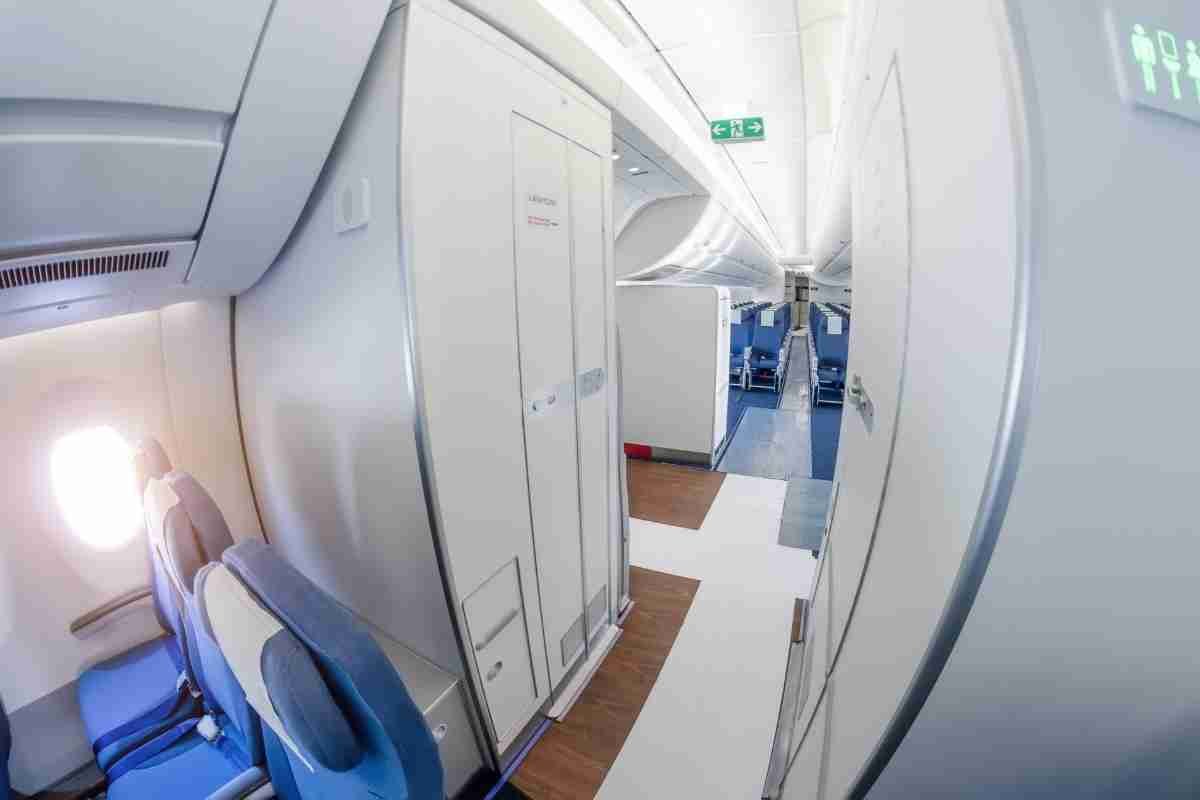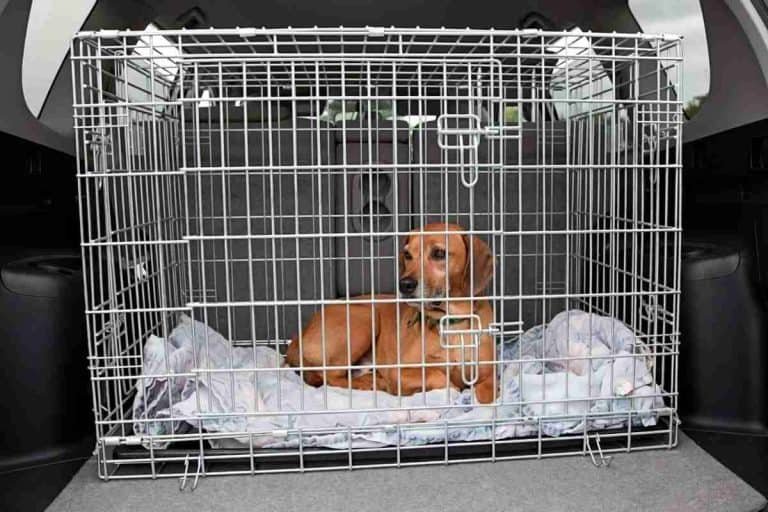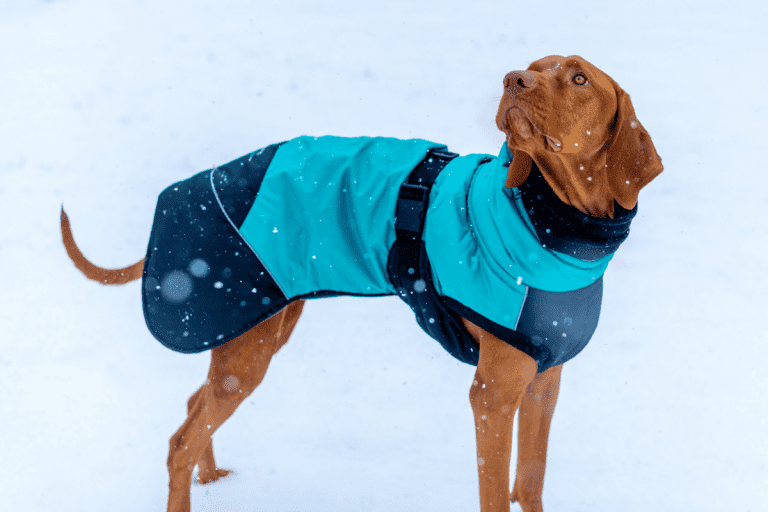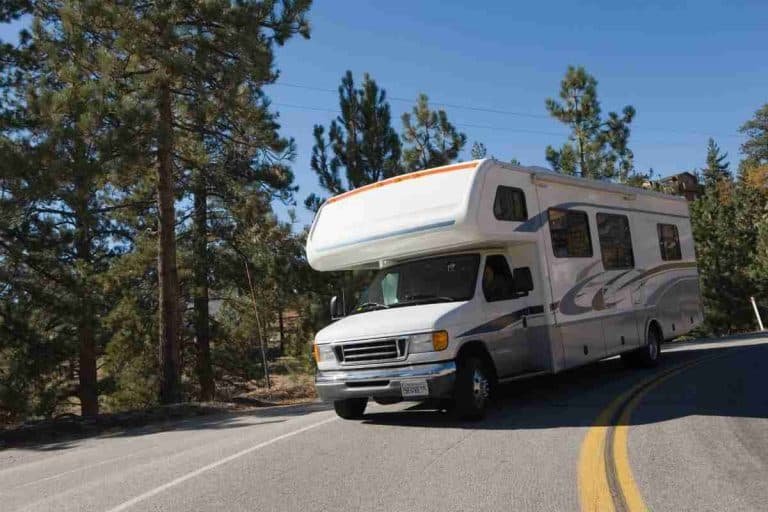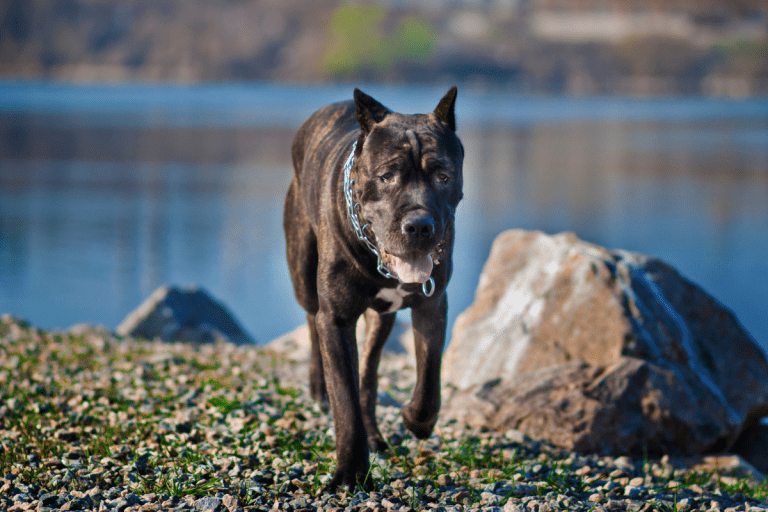Where Do Dogs Go to the Bathroom on a Plane? Airport Relief Areas, In‑Flight Options & Cargo Rules
Last Updated on September 2, 2025
Where Do Dogs Go to the Bathroom on a Plane? Planning determines it across airport relief areas, in‑flight options, and cargo rules. Travelers time preflight walks, locate indoor relief rooms, and set carrier pads for small dogs under the seat. Cargo travelers focus on sturdy crates, absorbent liners, and strict time and temperature limits.
Airline policies vary, so size limits, crew help, and service‑animal rules matter. This guide explains preflight routines, under‑seat carrier checks, and fast ways to find relief areas. It also covers cleanup steps, documentation, international differences, and a quick checklist to prevent surprises. The sections ahead provide steps that protect welfare, avoid fees, and keep cabins comfortable.
How bathroom needs are handled during air travel
Where Do Dogs Go to the Bathroom on a Plane? Planning determines the answer. Airlines and airports handle pet relief in different ways, and owners must prepare before arrival.
Most handling falls into three phases: preflight, at the terminal, and during travel. Preflight prep includes a walk or trip to an outdoor relief area within two hours of check‑in. For small dogs traveling in the cabin, a final bathroom break before boarding reduces in‑flight accidents. For dogs flying as checked cargo, handlers expect the owner to relieve the dog before drop‑off; carriers rarely provide mid‑flight potty breaks.
Carriers and physical size limits shape options. Airlines restrict in‑cabin pets to carriers that fit under the seat. For guidance on which breeds commonly fit that space, consult resources about dog breeds that fit under airplane seat. Owners should stock absorbent pads, sanitizing wipes, and a travel leash. Short flights may allow avoided accidents with careful timing. Long flights and tight layovers increase risk and may require booking direct or selecting airlines with better pet accommodations.
Typical places dogs relieve themselves (airport relief areas, in-cabin solutions, cargo protocol)
Airport relief areas exist in most terminals. They appear as outdoor grassy plots or indoor pet relief rooms with artificial turf and waste stations. Travelers should locate these on airport maps and use them when time permits. Security screens generally allow small collapsible potty mats through if carried in hand baggage.
In‑cabin solutions include absorbent pads placed inside carriers, portable faux‑grass trays, and disposable litter systems for very small dogs. Owners should place pads where the dog prefers and change them at layovers. Never force a dog to use a carrier pad it finds stressful; practice at home first.
For dogs traveling in cargo, airlines typically require the dog to be self‑contained in a sturdy crate and relieved before check‑in. Airlines that accept animals in the cargo hold have specific crate and labeling rules. See the guide on airlines that allow dogs in the cargo for airline‑specific requirements. Always bring proof of vaccinations and a familiar blanket to reduce stress during the wait before loading.
Why this matters — animal welfare, airline rules and passenger comfort
Proper bathroom planning matters for welfare, compliance and comfort. Holding urine or feces for extended periods raises the risk of infection and stress. Brachycephalic (short‑nosed) breeds face added respiratory stress, making efficient preflight relief critical. Airlines enforce rules; failure to comply can lead to denied boarding or additional fees.
Passenger comfort and cleanliness also depend on proper handling. Accidents in cabins create health and odor issues and can escalate tensions on crowded flights. Repeated noise or distress can trigger complaints; owners should review what happens in noisy or disruptive cases by reading posts like what happens if my dog barks on a plane. Airlines may require removal of a pet whose behavior threatens safety or comfort.
Practical steps: check the airline’s pet policy in advance, arrive early to use airport relief areas, and carry replacement pads and cleaning supplies. A final reminder card or note in the carrier with owner contact details can speed assistance if a gate agent must intervene. Travelers who verify rules and prepare accordingly protect their pet’s welfare and reduce surprises at the airport.
Preparing your dog before the trip
When planning travel around Where Do Dogs Go to the Bathroom on a Plane? Airport Relief Areas, In‑Flight Options & Cargo Rules, owners should prepare the dog well before the airport day. Proper preparation reduces accidents and stress, and helps comply with airline rules.
Train and practice — teaching your dog to use pads or unfamiliar surfaces
Start pad and surface training at least two weeks before travel. Teach the dog to relieve itself on absorbent pads, artificial turf, or puppy grass. Use short, frequent sessions and reward success immediately. Practice placing the pad inside a carrier so the dog accepts unfamiliar surfaces in confined spaces.
Feeding and watering schedule to reduce chances of accidents
Shift meals to the travel schedule three days ahead. Offer the last full meal four to six hours before departure for adult dogs. Limit water one hour before boarding but keep access until that point. For long connection times, schedule potty breaks at airport relief areas when possible.
Vet checks, required health documents and breed restrictions
Obtain a vet check within the timeframe the airline requires and carry printed health certificates. Verify breed restrictions, especially for snub-nosed dogs, and confirm age or vaccination rules. Call the airline to confirm documentation and any additional requirements before travel.
Travel supplies to pack (pads, waste bags, disposable liners, diapers, wipes)
Pack extras: absorbent pads, disposable carrier liners, diapers, waste bags, and unscented wipes. Include a collapsible bowl and a small towel. For gear recommendations and broader travel tips, see essential dog travel tips and gear for road trips. Keep supplies accessible during security checks and at the gate.
Using airport pet relief areas
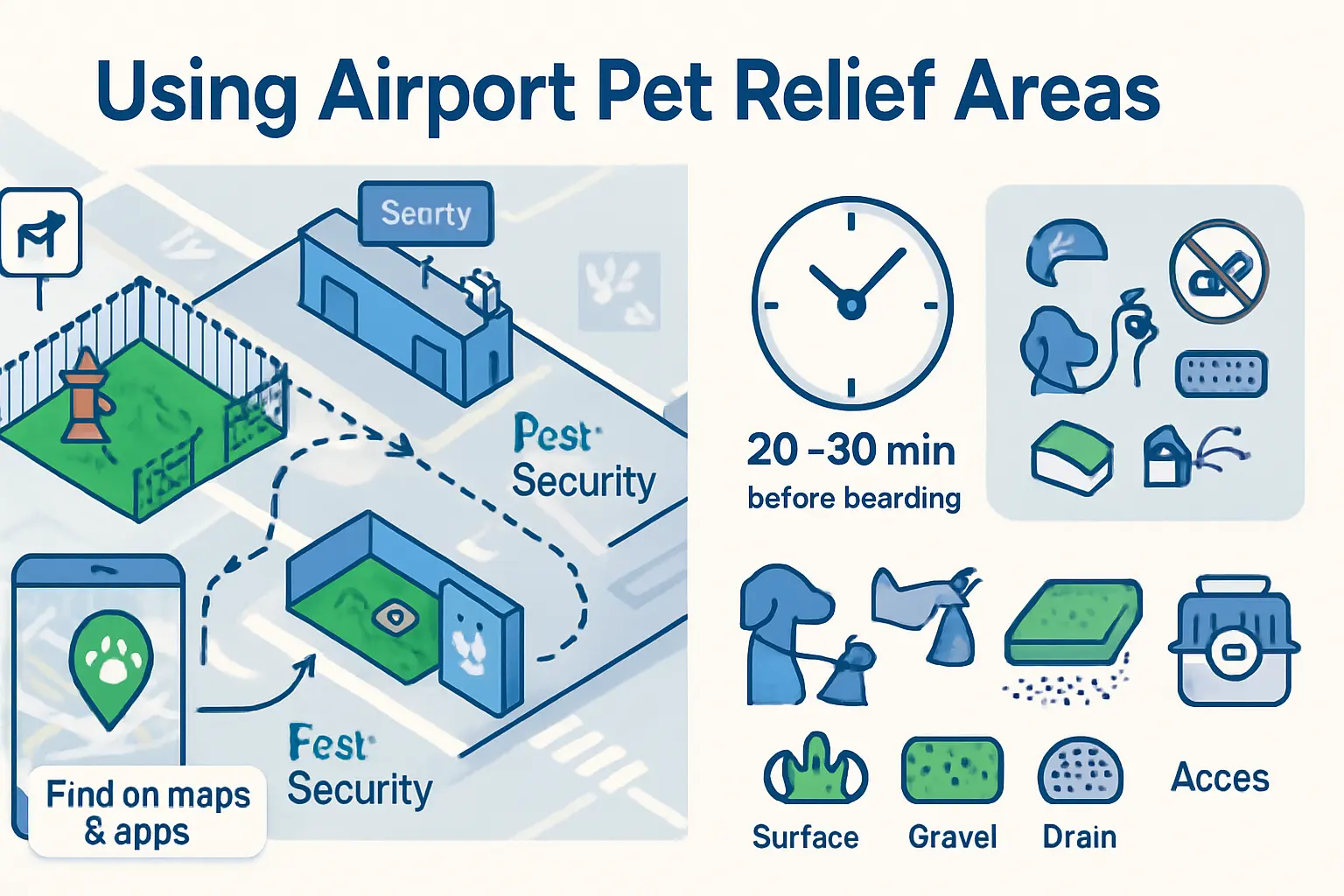
Where relief areas are located (pre- and post-security, indoor vs outdoor)
Airports place pet relief areas in predictable zones: curbside or pre-security plazas, and past security near gate concourses. Many larger airports provide indoor, climate-controlled relief rooms with artificial turf. Smaller airports often only offer outdoor fenced areas. Travelers should not assume restroom stalls count as pet relief.
How to find them quickly (airport maps, airline/airport apps, signage)
Most airports list relief areas on terminal maps and mobile apps. Airline apps sometimes highlight nearby pet facilities. Look for dog icons on signage or ask a gate agent when time is tight. For guidance on which carriers allow in-cabin pets and how that affects relief timing, see the dogs you can take on a plane resource.
Proper etiquette and what surfaces/fixtures to expect
Expect artificial turf, gravel beds, and simple drainage systems. Bring waste bags, disinfectant wipes, and a short leash or harness. Keep the dog on leash and away from benches or food-service areas. Always pick up waste and dispose of it in provided bins. Quick cleanup preserves access for other travelers.
Access rules for non-service pets and time considerations
Access varies by airport and airline. Pre-security areas normally welcome all pets; post-security spaces may restrict access to ticketed passengers. Service animals receive broader access. Allow at least 20–30 minutes before boarding for one final relief break. For long layovers, plan multiple visits and confirm hours through airport or airline apps before travel.
Managing bathroom needs during the flight (in-cabin)
Owners must plan bathroom options before boarding. Most airlines allow a small dog carrier beneath the seat, so giving the dog a long walk and a bathroom break at the terminal relief area reduces in‑flight accidents. For dogs that fit under the seat, packing absorbent pads, a small disposable tray and spare cleaning supplies cuts stress during longer flights. Short flights often tolerate a single pad; multi‑leg journeys require rotation and fresh pads between connections. Flight attendants enforce cabin cleanliness and will report repeated accidents, so preparation matters.
Small-breed travelers benefit from carriers sized to allow the dog to stand and turn, reducing anxiety and the urge to eliminate. For guidance on breeds and size limits that commonly fit under the seat, refer to dog breeds that fit under airplane seat. Owners should confirm carrier dimensions with the airline, measure the pet, and test carrier comfort at home.
In‑cabin options: potty pads, disposable trays, dog diapers and small‑breed considerations
In‑cabin options focus on containment and comfort. Potty pads work for brief, minimal output; place one inside the carrier and secure it so the dog cannot slide. Disposable trays with absorbent liners fit larger carriers and reduce cleanup. Dog diapers or belly bands add a backup layer but can cause skin irritation if left on too long. Rotate diapers every few hours and check skin for redness.
Small breeds often show more anxiety on flights. Select pads designed for small pets and choose low‑profile trays to maximize floor space. Train the dog to use pads before travel by simulating carrier conditions. For which dogs commonly travel in cabin and related tips, see dogs you can take on a plane. Pack an extra carrier liner, wipes, and a sealable bag for soiled materials.
Crew policies and when crew can/cannot help
Cabin crew prioritize passenger safety and cannot provide prolonged pet care. Crew will assist with basic containment guidance and cleanup for small incidents. They can supply plastic bags and occasionally disinfectant wipes, but they will not change pads, handle escapes, or administer medication. Crew cannot allow pets in aisles or lavatories for bathroom use due to safety and sanitation rules.
If a pet becomes unmanageable, crew follow airline procedures that may include notifying the captain, issuing warnings to the owner, or, in rare cases, requesting diversion. Owners should brief crew about medical conditions and any in‑flight requirements at boarding. For operational responses to noisy or distressed pets, review real scenarios at what happens if my dog barks on a plane. Clear communication with crew reduces misunderstandings and ensures faster assistance for legitimate emergencies.
Handling an emergency onboard and minimizing disruption
Emergencies range from sudden illness to a dog soiling itself from stress. The owner must act quickly and calmly to limit disruption. First steps: secure the pet in its carrier, isolate soiled materials into sealable bags, and contain odors with an absorbent pad. Offer water sparingly; vomiting or nausea requires veterinary attention post‑flight.
When a pet becomes noisy or distressed, use calming strategies already practiced on the ground, such as compressed wraps, gentle verbal reassurance through the carrier, and familiar-smelling items. Notify a flight attendant immediately for access to cleaning supplies and to inform nearby passengers. For behavioral issues and practical mitigation tips, consult dog whining on plane. Prepare a small emergency kit with spare pads, wipes, a travel towel, and a vet contact card to streamline response and minimize passenger disturbance.
When an in‑cabin dog might be required to travel in cargo instead
Airlines may require cargo travel for dogs that exceed cabin size limits, show aggressive behavior, or present health risks. Common triggers include incorrect carrier dimensions, breeds that airlines classify as too large to fit under seat, and dogs with respiratory or mobility issues that make safe in‑cabin placement impractical. Weather and aircraft type can also force cargo travel for safety reasons.
Owners should verify airline cargo policies and breed restrictions before booking. Some carriers publish lists and rules that dictate when a pet must travel in cargo; consult those materials in advance. For airline-specific cargo allowances and procedures, see airlines that allow dogs in the cargo. When cargo becomes necessary, prepare the dog with acclimation to the travel crate, attach clear identification and medical records, and schedule a pre‑flight vet check. Check policies and confirm bookings early to avoid last‑minute changes.
What happens when dogs travel in cargo

When an airline transports a dog in the cargo hold, ground and flight crews follow set procedures intended to protect the animal. Airlines prepare the kennel, monitor environmental controls, and limit how long pets remain unseen. Owners should understand kennel preparation, accident prevention, time and temperature limits, and the questions to ask before booking.
How airlines prepare kennels (absorbent bedding, anchors, water containers)
Airlines typically secure crates to prevent shifting during taxi, takeoff, and landing. Crew members add absorbent bedding and attach water containers designed to resist spills. Larger carriers use anchoring systems and labels indicating live animal status. Owners should verify whether the airline tops up water and if staff can access the crate during layovers.
Best practices for crate lining and comfort to reduce accidents
Layer the crate with a leakproof base tray, an absorbent pad, and a breathable top pad. Use a familiar blanket or shirt to reduce stress. Avoid towels that bunch; use non-slip material to keep the dog steady. For males, consider a secure belly wrap for long flights. Remove toys that could become choking hazards. A calmer dog produces fewer accidents.
Time limits, temperature control and safety concerns
Most airlines set explicit time limits between drop-off and pick-up. Avoid flights that create long ground holds in extreme heat or cold. Cargo areas may have separate climate zones, but temperature can vary. Brachycephalic breeds face higher risk and may be restricted. Sedation increases risk and usually receives firm airline restrictions. Confirm direct flights when possible to minimize time spent in cargo.
Questions to ask the airline before booking cargo travel
Ask whether the carrier operates a dedicated live-animal handling desk, climate-controlled cargo, and any breed-specific rules. Inquire about maximum allowed time in cargo, check-in and pickup windows, and on-site animal care during delays. Request crate size and construction requirements and whether the airline supplies or inspects bedding. For a list of carriers that handle dogs in cargo, see airlines that allow dogs in the cargo. Confirm policies and reserve the live-animal slot well before travel.
Service animals and emotional support animals — special rules
The title, Where Do Dogs Go to the Bathroom on a Plane? Airport Relief Areas, In‑Flight Options & Cargo Rules, frames why airlines and airports treat service animals differently from emotional support animals (ESAs). Service animals receive access under disability laws and most carriers allow them in the cabin without kennel restrictions. ESAs, however, lost broad air travel protections when many airlines and regulators reclassified them as pets. Airlines now set their own ESA rules, often requiring pet fees and specific paperwork.
Airlines expect working animals to behave and not disrupt other passengers. Handlers may need to present vaccine records, recent health certificates, or airline-specific forms. If a dog creates safety or sanitation issues, an airline can deny carriage. Behavior issues such as persistent barking can influence decisions during boarding and in flight; see guidance on what happens if my dog barks on a plane for handling conduct problems.
Handlers should confirm policies before travel and keep documentation handy. A quick phone call or online check reduces surprises at check-in and helps secure access to terminal relief areas and in-cabin accommodations.
Access to terminals and relief areas for service animals
Airports generally provide dedicated relief areas for service animals. These areas appear before and after security checkpoints. Some larger hubs include sterile-area relief patches inside the gate area. Security personnel typically escort or allow handlers to proceed through screening with a service animal.
Relief areas vary by airport. Most use artificial turf, drainage, and disposal bins. Airports expect handlers to carry waste bags and clean up after their animals. For dogs that travel in-cabin, handlers plan time for a last relief break before boarding. For cargo or checked travel, handlers use pre-security relief zones and ask airline staff about relief opportunities during layovers.
Travelers can find airport-specific maps on official airport websites. For guidance on which breeds and sizes commonly travel in cabins, consult practical resources like dogs you can take on a plane, which helps match animal size to available relief and seating options.
Documentation, advance notice and airline variations for ESAs vs service dogs
Airline policies differ widely. Service dogs usually require minimal documentation under disability protections, but carriers often request proof of training or a signed handler statement. ESAs frequently face stricter rules: many airlines now treat them as pets. That designation triggers carrier rules on carriers, fees, and kennel dimensions.
Handlers should notify the airline as early as possible. Advance notice secures cabin space and lets staff prepare relief accommodations at departure and arrival airports. Required documents can include vaccination records, a recent health certificate from a veterinarian, and an airline-specific behavior attestation.
Large or nontraditional service animals may travel under special conditions. Because rules vary, handlers must compare carriers before booking. Airlines with explicit large-dog cabin policies provide clearer pathways for travel; see examples at airlines that allow large dogs in cabin. Always upload or carry digital copies of required paperwork.
Tips for managing relief needs for working animals during long journeys
Planning prevents most in-flight and terminal bathroom issues. Handlers should exercise a service dog before travel and offer a final relief break close to boarding time. Limit food three to four hours before departure to reduce urgency, while keeping water available until an hour before travel.
Pack a compact relief kit: disposable pee pads, waste bags, disinfectant wipes, a lightweight leash or harness, and a foldable water bowl. For male dogs, consider a belly band for added security on long flights. For dogs that travel in cargo, coordinate with the airline about check-in timing and pre-boarding relief. During long layovers, request access to sterile-area relief zones when available.
Train the animal to use pads and public relief surfaces before travel. Keep trips calm with short walks during layovers. For more general travel gear and planning tips, handlers can consult essential dog travel tips and gear for road trips, which adapts well to air travel preparation. Check carrier policies and arrive early to manage relief needs smoothly.
If your dog has an accident at the airport or on the plane

Accidents happen, especially when travel disrupts a dog’s routine. The priorities are containment, hygiene, and clear documentation for any follow-up with the airline or airport. Act quickly to limit spread, protect belongings, and keep the dog calm and safe. The steps below assume the incident occurred either in the terminal, gate area, or inside the cabin.
Immediate steps: contain, clean, protect your belongings and your dog
First, move the dog a short distance away from the soiled area to a stable, secure spot. Put down an extra absorbent pad or a plastic liner under the carrier or leash to prevent further spread. Use disposable gloves and paper towels to remove solid waste, seal it in a plastic bag, and discard in a public trash receptacle.
Blot liquids with absorbent towels rather than rubbing. Apply a pet-safe enzymatic cleaner to fabrics and hard surfaces when available. For a dog’s paws or fur, gently wipe with pet-safe wipes and dry thoroughly to avoid chilling. Protect valuables by placing them in sealed bags until they can be cleaned.
Photograph the scene and any soiled items immediately for documentation. For practical tips on handling pet messes while traveling by vehicle, see dog poops in car.
How to request cleaning help or report an incident to the airline/airport
Alert the nearest gate agent or airport staff right away. Ask them to call for custodial services if the mess involves airport flooring, seating, or carpeted areas. If inside the cabin, inform a flight attendant as soon as it is safe to do so; crew can often provide disposable cleanup supplies or arrange deeper cleaning after landing.
Record names, badge numbers, and timestamps when staff respond. Take photos of the area and soiled items before any cleaning. File a formal incident report with the airline’s customer service desk or online portal, attaching photos and receipts. Airlines have different timelines and forms for pet-related claims, so request confirmation and a reference number.
For context on how airlines typically respond to pet-related incidents and passenger reports, review guidance at what happens if my dog barks on a plane.
Preventing lingering odors and handling claims or fees
Address odors promptly to prevent permanent staining or lingering smells. Use enzyme-based cleaners on fabric, foam, and carpet; they break down organic residue rather than masking it. For soft carriers and bedding, remove covers and launder on hot (if fabric care allows). For non-washable items, sprinkle baking soda, let sit, then vacuum, or place items in fresh air for several hours.
Save all cleaning receipts and any airline communications. Submit claims quickly—most carriers set short windows for pet-incident reimbursement. If the airline charges a cleaning fee, request an itemized invoice and dispute any unreasonable charges with supporting photos and receipts. Consider filing a complaint through customer service, then escalate to the airline’s claims department if necessary.
Stock travel gear that prevents future messes: absorbent pads, a small enzymatic cleaner, spare bedding, and a compact carrier liner. See recommended travel supplies at essential dog travel tips and gear for road trips. Contact the airline’s pet department within 24–48 hours to start a formal claim if fees or damage claims arise.
Quick pre-flight checklist and frequently asked questions
Short travel checklist you can print or save (potty before departure, supplies, paperwork, locate relief areas)
Owners should complete a short checklist the day before travel and again at the airport. Key items:
- Potty: Give a long outdoor walk and a final bathroom break just before leaving for the airport.
- Supplies: Absorbent pads, spare leash, collapsible bowl, bottled water, small towel, and waste bags.
- Carrier/crate: Airline-approved dimensions, comfort bedding, and clear ID on the crate.
- Paperwork: Current vaccination records, health certificate (if required), and proof of microchip registration.
- Locate relief areas: Save terminal maps and relief-area locations on a phone or print them.
For a quick primer on which dogs commonly travel in-cabin and related restrictions, see dogs you can take on a plane.
FAQs: How long can dogs hold it? What about puppies or senior dogs? Can I medicate my dog? International differences and quarantine concerns
Healthy adult dogs typically manage 6–8 hours with a long walk beforehand. Puppies and seniors need more frequent opportunities; puppies often need one hour per month of age. Sedatives and strong tranquilizers carry risks with pressurized cabins and are usually discouraged. Owners should consult a veterinarian about anti-nausea or mild calming options and get written guidance before travel. International travel adds layers: some countries require rabies titers, specific vaccines, or quarantine periods. Plan paperwork weeks or months ahead and verify destination rules to avoid last-minute holds or quarantine.
Where to get reliable airport and airline pet-policy information (official links and apps)
Owners should always confirm details with primary sources. Check the airline’s official pet policy page and the airline app for real-time updates on fees and size limits. Airport websites list terminal maps and pet relief locations. The TSA website covers screening procedures for animals in the cabin. When rules conflict, the airline’s published policy and a vet’s written clearance take priority. CTA: review airline pet pages and the destination’s import rules before purchasing tickets.
Summary
Where Do Dogs Go to the Bathroom on a Plane? Airport Relief Areas, In‑Flight Options & Cargo Rules comes down to planning and matching a dog’s needs to airline and airport options. Most relief happens before boarding at designated airport areas; in cabin, owners rely on trained use of pads, low‑profile trays, and backups like diapers; and in cargo, a properly lined crate and smart scheduling reduce accidents. Breed, size, flight length, and carrier rules shape what is realistic, while crew policies limit in‑flight help.
Success looks like this: verify policies early, train on pads and unfamiliar surfaces, time meals and water, locate relief areas, and pack the right supplies. For cargo, confirm crate specs, temperature limits, and handling windows. With preparation and clear communication, travelers protect animal welfare, stay compliant, and avoid messy surprises.
Key Takeaways
- Plan relief in three phases: long walk and final break before check‑in, use airport relief areas pre/post security, and rely on trained pad use during flight if needed.
- Match solutions to the cabin: secure an absorbent pad or low‑profile tray in the carrier, rotate fresh liners on connections, and carry wipes, bags, and spare bedding; never use the lavatory for pets.
- Time food and water: shift meals to the travel schedule, feed 4–6 hours before departure, and limit water about an hour pre‑boarding for adult dogs.
- Cargo requires extra care: line the crate with leakproof layers, attach spill‑resistant water containers, avoid extreme temperatures, and favor direct flights; confirm breed and crate rules.
- Know access rules: service dogs have broader cabin and relief‑area access; ESAs often follow standard pet policies with fees and carrier limits.
- Handle incidents quickly: contain, clean with enzyme products, notify staff, document if fees or claims arise, and replace soiled pads or liners promptly.
FAQ
-
How can travelers prevent in‑flight accidents for in‑cabin dogs?
Give a final relief break just before boarding, use a properly sized carrier with a secured pad or tray, and train the dog to use pads in confined spaces. Rotate fresh pads on layovers and pack wipes and sealable bags.
-
What in‑cabin bathroom solutions are typically acceptable?
Absorbent pads, disposable liners, and low‑profile trays inside the carrier are common; diapers or belly bands add backup for longer flights. Keep everything contained within the carrier and confirm any airline‑specific limits.
-
How do airport pet relief areas work and how are they found quickly?
Relief spots are located pre‑ and post‑security and marked by dog‑icon signage; many airports list them on maps and apps. Allow 20–30 minutes before boarding to visit and always clean up using provided waste stations.
-
Why might a dog be required to travel in cargo instead of the cabin?
Size, carrier noncompliance, behavior concerns, aircraft constraints, or breed and weather restrictions can trigger cargo travel. Verify rules and reserve space early to avoid last‑minute denials.
-
What happens if a dog soils the carrier or cabin?
Contain and bag waste, swap in a fresh pad or liner, and alert crew or airport staff for additional cleaning as needed. Document the incident if fees or claims are possible.

